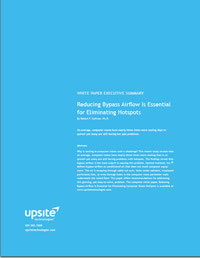Pioneering Study Outlines Findings and Methods to Eliminate Data Center Hot Spots by Reducing Bypass Airflow
This White Paper Presents:
- What’s Happening in the Computer Room – how uncontrolled cooling causes excessive data center heat loads and how previous tactics, such as increasing computer room air conditioning units, only made problems worse
- Why and How Issues Arise – case studies show how bypass airflow occurs
- Testing and What to Avoid – the best ways to conduct remediation testing and baseline case studies
- Problem Solving – recovering wasted bypass airflow
- Getting Results – statistic based improvements, which reduced bypass airflow and computer room temperatures
- Addition Benefits – eliminating hot spots increased the performance of data center operations while saving energy, reducing operating expenses and capital investments related to computer room air conditioning units
In data centers across the country, consistent and reliable data center operations is continually being compromised by data center hot spots. As manufacturers continue to introduce high-heat density equipment and computer room capacity requirements grow, data center hot spots will get worse.
This white paper, written by the Uptime Institute, is based on years of conducting computer room monitoring, testing, surveys, and case study research, which was gathered to pinpoint the causes behind data center cooling and data center management issues.
The findings are counter to original beliefs that insufficient computer room air conditioning units or high heat densities were the underlying cause of computer room cooling issues. After collecting more than 15,000 individual measurements in 19 computer rooms ranging in size and capacity, the culprit was actually an issue called “bypass airflow.”





